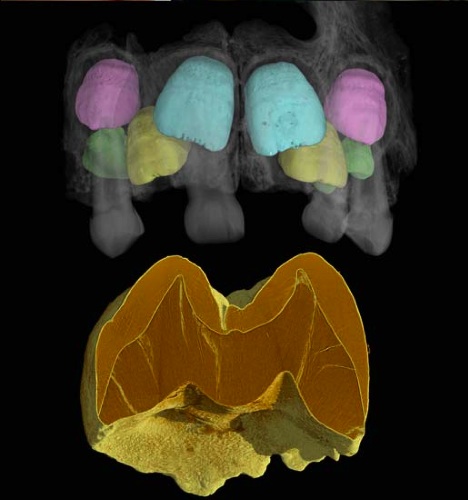Los investigadores de la Universidad de Harvan utilizaron el sincrotrón europeo ESRF, en concreto el del departamento de paleontología que dirige Paul Tafforeau. El potente haz del sincrotrón permitió reconstruir con detalle las líneas de crecimiento, como los anillos de los árboles. Ello permite conocer la edad de los dientes de manera bastante precisa. Es importante la técnica ya que permite realizar este estudio sin destruir el diente, como tradicionalmente se realiza.
Según este trabajo los individuos de Homo sapiens maduran de manera más lenta que cualquier otra especie de homínido, incluyendo las más cercanas a nosotros. Así los neandertales tiene un crecimiento intermedio entre los Homo más primitivos y los modernos sapiens. Esto sugiere que la adquisición de este carácter se produjo de una manera lenta en los representantes de Homo. El desarrollo lento en los individuos juveniles los hace más vulnerables, pero por otra parte representa una oportunidad para mejorar el aprendizaje y la cognición compleja, base del desarrollo cultural humana.
Más información en el País Digital
La referencia completa es Smith, T.M., Tafforeaau, P. et al., 2010. Dental evidences for ontogenetic differences between modern humans and Neanderthals. PNAS, doi: 10.1073/pnas.1010906107
Para los más interesados, aquí os dejamos el resumen
Humans have an unusual life history, with an early weaning age, long childhood, late first reproduction, short interbirth intervals, and long lifespan. In contrast, great apes wean later, reproduce earlier, and have longer intervals between births. Despite 80 y of speculation, the origins of these developmental patterns in Homo sapiens remain unknown. Because they record daily growth during formation, teeth provide important insights, revealing that australopithecines and early Homo had more rapid ontogenies than recent humans. Dental development in later Homo species has been intensely debated, most notably the issue of whether Neanderthals and H. sapiens differ. Here we apply synchrotron virtual histology to a geographically and temporally diverse sample of Middle Paleolithic juveniles, including Neanderthals, to assess tooth formation and calculate age at death from dental microstructure. We find that most Neanderthal tooth crowns grew more rapidly than modern human teeth, resulting in significantly faster dental maturation. In contrast, Middle Paleolithic H. sapiens juveniles show greater similarity to recent humans. These findings are consistent with recent cranial and molecular evidence for subtle developmental differences between Neanderthals and H. sapiens. When compared with earlier hominin taxa, both Neanderthals and H. sapiens have extended the duration of dental development. This period of dental immaturity is particularly prolonged in modern humans.
Según este trabajo los individuos de Homo sapiens maduran de manera más lenta que cualquier otra especie de homínido, incluyendo las más cercanas a nosotros. Así los neandertales tiene un crecimiento intermedio entre los Homo más primitivos y los modernos sapiens. Esto sugiere que la adquisición de este carácter se produjo de una manera lenta en los representantes de Homo. El desarrollo lento en los individuos juveniles los hace más vulnerables, pero por otra parte representa una oportunidad para mejorar el aprendizaje y la cognición compleja, base del desarrollo cultural humana.
Más información en el País Digital
La referencia completa es Smith, T.M., Tafforeaau, P. et al., 2010. Dental evidences for ontogenetic differences between modern humans and Neanderthals. PNAS, doi: 10.1073/pnas.1010906107
Para los más interesados, aquí os dejamos el resumen
Humans have an unusual life history, with an early weaning age, long childhood, late first reproduction, short interbirth intervals, and long lifespan. In contrast, great apes wean later, reproduce earlier, and have longer intervals between births. Despite 80 y of speculation, the origins of these developmental patterns in Homo sapiens remain unknown. Because they record daily growth during formation, teeth provide important insights, revealing that australopithecines and early Homo had more rapid ontogenies than recent humans. Dental development in later Homo species has been intensely debated, most notably the issue of whether Neanderthals and H. sapiens differ. Here we apply synchrotron virtual histology to a geographically and temporally diverse sample of Middle Paleolithic juveniles, including Neanderthals, to assess tooth formation and calculate age at death from dental microstructure. We find that most Neanderthal tooth crowns grew more rapidly than modern human teeth, resulting in significantly faster dental maturation. In contrast, Middle Paleolithic H. sapiens juveniles show greater similarity to recent humans. These findings are consistent with recent cranial and molecular evidence for subtle developmental differences between Neanderthals and H. sapiens. When compared with earlier hominin taxa, both Neanderthals and H. sapiens have extended the duration of dental development. This period of dental immaturity is particularly prolonged in modern humans.
LUGAR



















